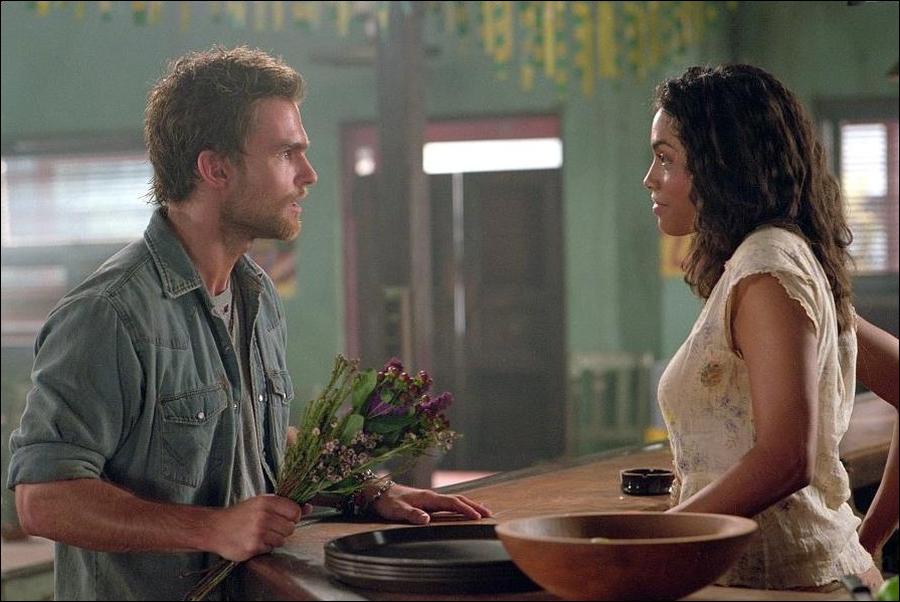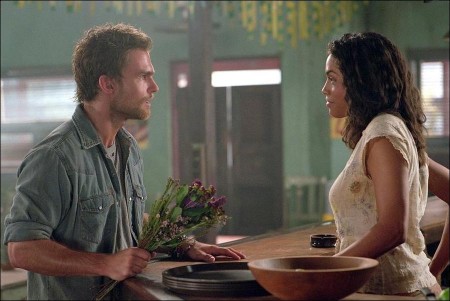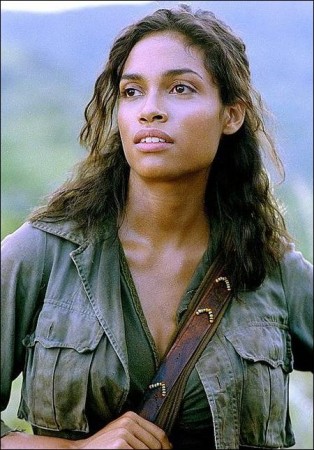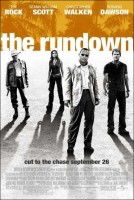A contemporary action-comedy set against the raw, untamed landscape of the Amazon was the perfect melding of genres for The Rock as a follow-up to his first starring roles in The Scorpion King and The Mummy Returns (his big-screen debut).
“The last two movies I’ve done, well, the only two movies I’ve done,” quips the star, “were period movies. So I was looking forward to doing something contemporary, playing a character with some mystique while injecting a little humor without losing the spirit of the character. Beck is the quintessential reluctant hero, one of those classic characters who can handle any situation, but whose problems just keep piling up.”
While in production on The Scorpion King, producer Kevin Misher (former President of Production at Universal Pictures) and The Rock had discussed collaborating on another project. Producer Karen Glasser had recalled a compelling, two-fisted adventure story she had read and brought it to The Rock and Misher’s attention. Once The Rock expressed interest in the Amazon-set action-adventure, Universal Pictures quickly set the project on the fast-track. Everyone agreed that it had elements that were both familiar and innovative to a no-holds-barred action film and that The Rock, who was poised for stardom after his charismatic turn in the worldwide hit The Scorpion King, should be its hero.
Producer Marc Abraham came on board soon after, and the team developed the script for the action star, making sure that the story amply showcased his natural athletic ability and impressive comedic acting, not yet tapped on the big screen but which audiences got a glimpse of with The Rock’s standout appearances hosting Saturday Night Live.
“The remarkable thing about The Rock is he’s very capable of performing the stunt, often better than most stunt doubles. The great fun in all of this is that you keep the camera rolling and the audience knows it’s him pulling off these incredible stunts. And on top of all of that is his style and his on-screen presence. Of course, as a producer you’re thinking ‘What are we doing, that’s our star out there!’” comments Misher.
“Anyone who knows The Rock knows that he is very witty and charming,” adds Abraham, “and The Rundown gives him a chance to showcase those qualities on screen. He has great instincts as a performer. And his career as an athlete gave him incredible drive and discipline, but the truth is, he was just born with natural star power.”
Director Peter Berg, well known as a film and television actor (The Last Seduction and Cop Land), emerged as a director on the critically acclaimed television series Chicago Hope (in which he also starred) and made his feature debut as a writer/director with the black comedy Very Bad Things.
It was Berg’s training in and understanding of performance and his sharp, singular approach to the film that made him a leading candidate to visualize the hardhitting action of the film and still maintain its many differing and unique elements.
“On paper, Pete may not have been a natural choice to helm a big, action film,” observes Misher. “But he’s proven himself as an actor and a director with keen sensibilities in dealing with genre-breaking projects—and The Rundown isn’t your standard action fare. The elements that make it different and special, such as the character work and the humor, dovetail perfectly with Pete’s proven strengths as a director. But on top of that, he also really stepped up to the challenge and delivered a kinetic, exciting, visceral film of big action that includes these colorful characters in compelling situations.”
“What made Pete a great choice,” remarks Glasser, “is that I think he really understands conflict. Whether a movie is a comedy or an action film, there needs to be an underlying tension and Pete really gets that. Obviously, he understands characters really well and an actor’s process and what an actor needs. His vision for the action has been very creative. He wanted to turn things upside down and play with them, which just comes from who he is.”
The director was enthusiastic about signing on to a project with The Rock in the lead. In addition to The Rock’s prior film work, Berg was struck by his WWE performances and remembers, “When The Rock appeared in these giant stadiums, he would deliver these long monologues where he would go off, taunting members of the audience or taunting other wrestlers, and it was real theater. And his audience was galvanized—35,000 people and he had them right in the palm of his hand. And I realized that the guy has tremendous acting chops and a commanding presence and he had been honing them every day, learning how to control an audience. So I was confident in his ability to hold his own in any situation, even with a veteran like Christopher Walken.”
Much like the tough action work the professional athlete executed in his football and wrestling career, the sequences of The Rundown are The Rock, pure and simple—in both cases, the action is completed in large part by the star without the benefits of postproduction magic substituting a CGI Beck for The Rock’s Beck.
The filmmakers were ever mindful of the star’s commitment to authentic physicality. Producer Abraham notes, “Whenever we were working on an action set piece that involved The Rock, we made every attempt to shoot it without trickery. It’s Rock’s face on his body in those sequences. This is a star who really can do his own stunts.”
Berg echoes Abraham when he says, “I think he’s a new type of action actor. He really is. He’s not anything that I’ve been able to easily define. And his ability to take risks and to try new things and to want to learn always surprised me and made me just want to pull for him that much more.”
For the role of Travis, the filmmakers found the perfect foil to The Rock in actor Seann William Scott, best known for his comedic role as the iconic arrested adolescent Stifler in the American Pie trilogy. Scott was eager for a role that was different from his previous work and collaborated closely with Berg to ensure that Travis retained the edgy quality that had initially attracted him to the character, but also gave him a chance to “graduate” from the previous roles he so indelibly created.
Scott says, “This has been the first movie where I’ve been able to give a lot of input…I wanted to play a guy who’s a little bit older and smarter and a little bit off, and Pete was all for that.”
“These two guys,” reasons Berg, “work quite well because there’s a tremendous contrast in the personalities. These are two characters who clearly would never spend two minutes with each other unless they were absolutely forced to. The Rock and Seann’s styles mesh perfectly with their characters. I think Seann has real charisma. If you look at his performances as Stifler, underneath all that beautiful nonsense is a very crafty performer. And I thought that he had legitimate fire burning underneath, which is such a commodity for an actor.”
“You will see a Seann William Scott that you haven’t seen before,” adds Glasser, “He’s not goofy, though Travis is slightly half-cocked. I think what’s fun about him is that there is something always slightly unexpected about what he’s going to do. Seann is fearless in terms of casting himself out there and seeing what happens.”
The Rock was enthusiastic when Scott’s name was first mentioned for the role of Travis. Once the filmmakers saw the immediate and effortless chemistry between the two they realized they had their match.
“I have the best time with Seann,” remarks The Rock. “It’s just so easy working with him. He takes his work very seriously yet, at the same time, he loves to have fun. Off-screen, we have become great friends. It’s non-stop laughter, continuously ragging and joking on each other. Hopefully that dynamic will come across on-screen as well.”
“How the characters react to one another in the middle of all of this action establishes the personality of the film. The contrasting nature of Travis’ manic electricity and Beck’s imposing stoicism as played by Seann and Rock is the real draw of the film,” Misher enthuses.
Scott was more than appreciative of Berg’s acting roots and compliments, “I’ve never really felt so trusting and understood as I have with Pete. We both have an offbeat sense of humor, so it’s perfect. Some of the things that I would normally think are funny and hesitant to explore—he’s right in tune with me. He’s a director who’s cerebral and very aware of trying to tell a story and create good characters. Otherwise, if you’ve got all this great action and there’s no story, nobody is going to care.”
Academy Award winner Christopher Walken, a recent Oscar® nominee for his performance in Catch Me If You Can, was cast as Hatcher, a hold-out from Brazil’s gold rush boom of the 80’s who continues to plunder the countryside using the impoverished locals to make his personal fortune.
The filmmakers hoped Walken, an actor known for creating memorable characters even with limited screen time, would inject his own trademark quirky malevolence to an atypical villain. Says Walken of his portrayal of the despot, “All villains have to have a rationale and Hatcher thinks he’s bringing civilization to the jungle. He tries to justify that by being a citizen of the world and helping the downtrodden. He’s terrible.”
The director notes, “It was a thrill watching Chris Walken. He’s just truly a guy that could read the phone book and you would sit there and listen to him. Just one sentence with him is simultaneously terrifying, confusing and hilarious…and endearing, probably, and all at once.”
To which Walken adds, “Peter’s a wonderful actor and it enhances his direction.” Recalling the sometime exhausting 14-week location shoot, Walken comments, “He handles it all with total grace and ease.”
Rosario Dawson, the sole woman among the principal cast, portrays the enigmatic Mariana, who slips into the role of moral compass for both Beck and Travis. For Dawson, the film’s action was the icing on the cake but the true appeal of the project was the chance to play a woman tough enough to hold her own in the jungle against all of these guys.
Dawson comments, “Everyone will enjoy the action and the adventure—it’s incredible. But what made it great for me, in addition to the obvious of playing opposite The Rock and Seann, was that Mariana isn’t just ‘the girl in the story.’ She actually turns out to be a key to the plotline—there are layers and things that the audience doesn’t know about her. And that is what an actor loves to play.”
Berg simply adds, “Rosario’s talent, her presence, her smile—she is great as the third side in this power struggle between Beck and Travis, giving Mariana a depth and mystery that’s really great for the story.”
Rounding out the cast of characters are Scottish actor Ewen Bremner as Declan, the eccentric bush pilot who flies Beck into the Amazon; Jon Gries, who portrays Harvey, the other crazy Hatcher brother; and Ernie Reyes, Jr., a martial arts championturned- actor who portrays Manito, a Brazilian rebel who squares off against Beck in an amazing Andy Cheng-choreographed battle of strength and wits.
About The Production
Essential to crafting a believable character who has an aversion to guns and relies more on hand-to-hand combat, the filmmakers and The Rock agreed that they needed someone who understood the visual aspects of a fight as much as the physical and could translate that into evocative and original fight sequences. Andy Cheng, a fight choreographer who worked with The Rock on The Scorpion King, fit the bill on all counts.
Director Berg observes, “Andy Cheng did a wonderful job of taking what was a Hong Kong-influenced style of fighting and reinventing it. He took the acrobatics of the style and customized it to the Brazilian jungle setting. What comes across is a believable combat style for these guerilla-style rebels. So now, in some ways, it’s like he invented a new style of fighting.”
The Rock explains, “Andy Cheng has a modern approach to designing fights that incorporates everything—strength, speed and agility—that people can relate to. He always wants to make things different which, in turn, makes Andy very unique.”
Adds Misher, “Andy has the eye on how to put action on the screen, without equal. He’s the guy who knows how to do something that people haven’t seen before and puts a fresh spin even if you think you have.”
Cheng, who also serves as a second unit director (with additional second unit direction from E.J. Foerster) worked closely with Peter Berg to inject creative (and sometime humorous) elements into the picture’s plentiful action. Both The Rock and Scott were very focused as they prepared for their physically demanding roles. The resulting transformations are evident in both of their leaner physiques, particularly for The Rock, who shed close to 40 pounds for the role.
The Rock wasn’t the only one the filmmakers were looking at to deliver some of the film’s eye-popping action. To their delight, they found in Scott an actor ready, willing and able to delve into the more physical aspects of the role. Scott had recently completed shooting Bulletproof Monk, a film that required five months of aerial wirework training and conditioning, so he too was geared up for what Cheng was envisioning.
“I love being physical,” explains Scott of the film’s action. “I like the action that I get to do. It’s not like I’m The Terminator or Rambo. Travis is the guy who’s not going to give up. He’s not a great fighter but he’s always bouncing back. It works really well with what Rock is doing.”
Extensive stunt rehearsals beginning in pre-production prepared The Rock and Scott for what the filmmakers had in store for them. Over the course of filming they both were strung upside-down from a 50-foot tree for a scene that filmed over several days; Scott dove from an exploding bus; and The Rock, strapped into aerial wires, was hurled more than 30 feet through the air.
The final climactic fight sequence, which takes place in and ravages the town of El Dorado, was particularly arduous for the actors. An elaborately choreographed sequence replete with fights, explosions, and hundreds of squibs detonating around the actors had them running, jumping and diving for cover—all quite safely, of course.
The jungle locale figured prominently into the script and although set in the Brazilian Amazon, the filmmakers thought the lush, vibrant beauty of Hawaii’s own rainforests—complete with towering Banyan trees, spectacular waterfalls and other breathtaking locales—offered a multitude of options for the film’s exotic setting.
Brazil was briefly considered for some of the film’s secondary locales, but a scouting trip to research design ideas for production designer Tom Duffield reinforced the decision to film entirely in the U.S. when Berg, Misher, Duffield, executive producer Ric Kidney and their escorts had an unexpected and frightening encounter with armed bandits outside the city of Manaus. (While the local guides pleaded for everyone’s safe release, the assailants relieved the group of their cash and camera equipment. Everyone safely returned stateside but in a unique example of art imitating life, the filmmakers felt compelled to utilize parts of their encounter for The Rundown, infusing the film’s dialogue, as well as costume and production design, with the experience.)
Before filming commenced on the Hawaiian island of Oahu, a kahu, a Hawaiian priest, presided over a traditional blessing, courtesy of The Rock, a former resident of the island, and the filmmakers. Five weeks of filming expansive jungle exterior scenes followed before the company returned to Los Angeles. Other locations used for filming included Hollywood, Hancock Park, the tropical garden of the Los Angeles Arboretum (which provided backdrop for the rebel campsite) and soundstages in Van Nuys, which housed several sets (including the ingeniously designed underwater cavern and tunnel which lead to the entombed Gato Diablo and the Amazones Bar where Mariana works).
Perhaps most notable, though, is the unique set for the village of El Dorado. Located 15 miles north of Los Angeles in the foothills of the San Gabriel Mountains, the enormous set was constructed within a four-acre parcel of land, which also included a work area for the crew and a holding pen for hundreds of animals.
Working closely with the U.S. Fish and Wildlife Service and a number of state and city agencies, the filmmakers commissioned a detailed environmental impact study, as well as ornithological and ichthyological surveys of the area, to ensure that production’s presence did not have any permanent ecological affects before they broke ground on the film set.
Production designer Duffield and his department designed, constructed and landscaped the village, which gave the filmmakers an inordinate amount of creative and technical options for filming. Duffield and his team (working with greens coordinator Danny Ondrejko) brought in hundreds of pounds of red dirt and thousands of tropical plants to lay the foundation for the enormous set.
What followed were over two months of labor-intensive construction of 50 structures that make up El Dorado—including a church, markets, bars, restaurants, homes and Hatcher’s two-storey concrete observation deck, flanked by 500-foot hills of molded dirt (fashioned from red-tinted wood and plaster) that border the gaping gold mine.
The jungle setting was completed with large-scale landscaping of coconut, palm and banana trees, ferns and other tropical plants—all supported by their own irrigation system.
“We literally created a tropical rainforest in the desert,” points out Duffield of the maintenance for the site.
With a discerning level of detail, set decorator Gary Fettis accented the town with every sort of embellishment—from markets overflowing with Brazilian candy, posters, magazines, cigarettes and canned food to several rusted-out early model automobiles sitting on cinder blocks. Brazilian background artists filming on the sets were amazed to recognize hometown brands placed throughout the sprawling set. The Rock, commenting on the detail that went into constructing the village, says, “What’s amazing to me is that you can literally be dropped right in the middle of this set with your eyes closed, only to open them and think you’re in a small South American town. The art department did an incredible job.”
In addition to looking authentic, however, the set also had to withstand the rigors of two film units filming the large-scale action movie, sometimes simultaneously. At times a visit to the set found horses, cattle, pigs, chickens, hundreds of background players, explosions, buildings shredded by gunfire, and dozens of fires burning—all simultaneously—while cast and crew executed their jobs in various areas of the set.
El Dorado handled the punishment of filming well, but the true test for the makeshift town was several days of unexpected high winds courtesy of Mother Nature. The film crew was plagued with fierce dust storms of red dirt that made it difficult to see (let alone film). Tin-roofed structures and tropical plants sustained minor damage but as a testament to its sturdy construction, all was easily repaired.
Nevertheless, when filming concluded, Duffield and his crew began returning the area to its original condition, beginning with the demolition and removal of the structures, dirt and plants. Once completed, the process continued with a re-grading of the entire area to its original topography and re-vegetating the surrounding area, followed by several months of monitoring the area as it settled back to pre-Rundown “normal.”
The Rundown
Directed by: Peter Berg
Starring: Dwayne Johnson, Seann William Scott, Christopher Walken, Rosario Dawson, William Lucking, Ewen Bremner
Screenplay by: James Vanderbilt, Kario Salem
Production Design by: Tom Duffield
Cinematography by: Tobias A. Schliessler
Film Editing by: Richard Pearson
Costume Design by: Louise Mingenbach
Set Decoration by: Gary Fettis
Music by: Harry Gregson-Williams
MPAA Rating: PG-13 for adventure violence, some crude dialogue.
Studio: Universal Pictures
Release Date: September 26, 2003




